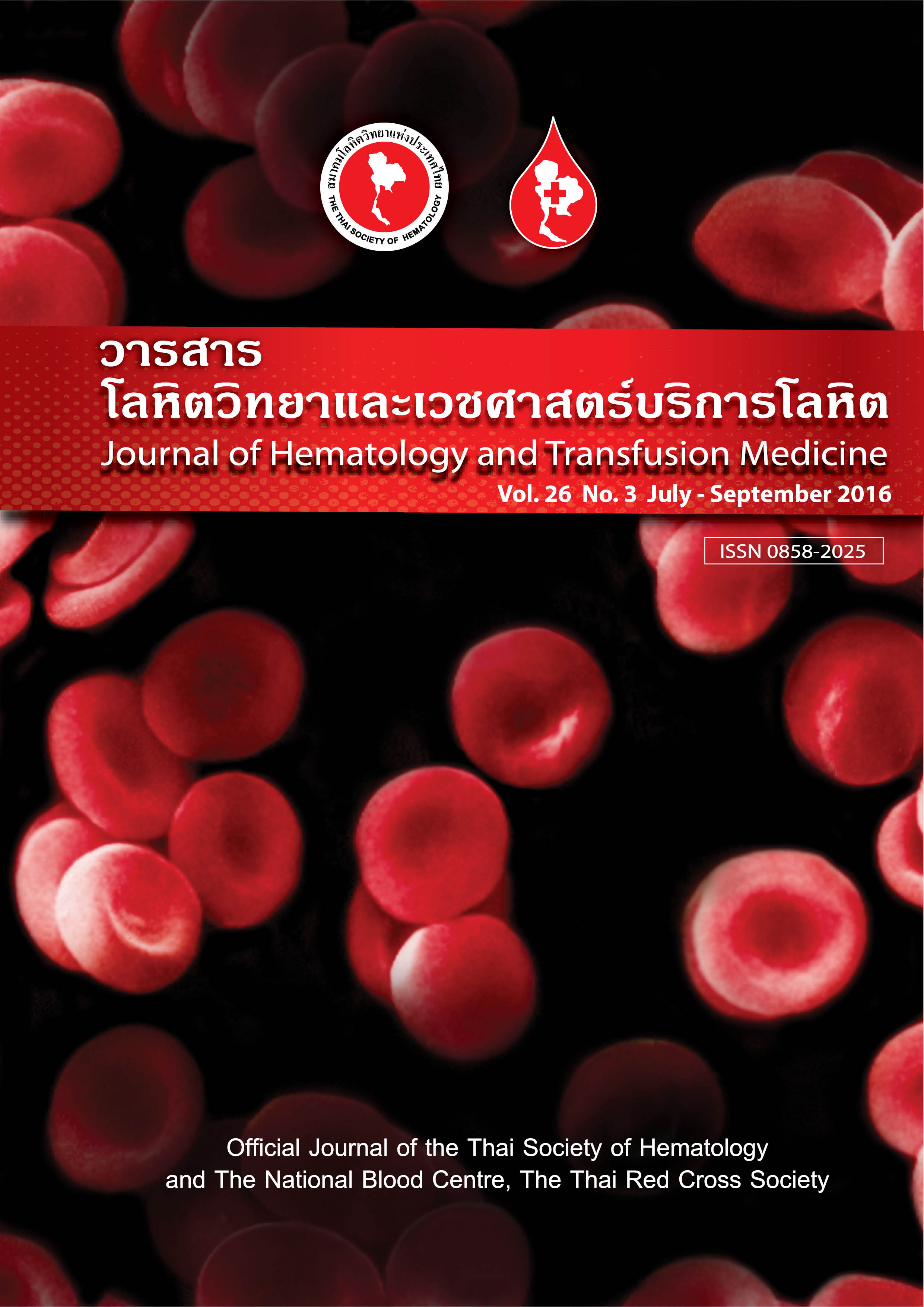การส่งตรวจ Ferritin และ Iron Studies ที่ไม่เหมาะสมในเวชปฏิบัติ
คำสำคัญ:
ferritin, iron studies, inappropriate, costบทคัดย่อ
บทคัดย่อ
ความเป็นมา การส่งตรวจทางห้องปฏิบัติการที่ไม่เหมาะสมก่อให้เกิดภาระงานที่เพิ่มขึ้นและมีความสิ้นเปลืองค่าใช้จ่ายทางสาธารณสุข วัตถุประสงค์ ศึกษาความชุกสาเหตุที่พบบ่อยและหน่วยงานที่ส่งตรวจ ferritin หรือ iron studies และพิจารณาความเหมาะสมวิธีการ ศึกษาเชิงวิเคราะห์ความเหมาะสมในการส่งตรวจ ferritin หรือ iron study ณ จุดเวลาใดเวลาหนึ่ง ของผู้ป่วยที่โรงพยาบาลศรีนครินทร์ ระหว่างเดือนมกราคมถึงมิถุนายน 2557 ผลการศึกษา ช่วงเวลา 6 เดือน (มกราคมถึงมิถุนายน 2557) มีการส่งตรวจ ferritin 227 ครั้ง iron studies 94 ครั้ง และทั้งสองอย่างร่วมกัน 998 ครั้ง รวม 1,319 ครั้ง จากผู้ป่วยทั้งสิ้น 1,051 ราย ชายต่อหญิง 1:1.3 (ร้อยละ 44.3: 55.7) เฉลี่ยความถี่การส่งตรวจรายละ 1.25 ครั้ง มีการส่งตรวจ ferritin หรือ iron studies ที่ไม่เหมาะสมร้อยละ 31.8 ส่วนใหญ่เกิดจากการส่งตรวจบ่อยกว่า 1 ครั้งใน 3 เดือน (ร้อยละ 46.4) และการส่งตรวจขณะมีภาวะการอักเสบติดเชื้อ (ร้อยละ 37.6) หน่วยงานที่ส่งตรวจ ferritin หรือ iron studies ที่ไม่เหมาะสมมากที่สุดคือ แผนกอายุรกรรมผู้ป่วยใน (ร้อยละ 45.2) และศัลยกรรม (ร้อยละ 40.4) ส่วนหน่วยงานที่ส่งตรวจ ferritin หรือ iron studies ที่เหมาะสมมากที่สุดคือ แผนกสูตินรีเวช (ร้อยละ 3.7) ค่าใช้จ่ายจากการส่ง ferritin หรือ iron studies ทั้งหมด 663,670 บาทต่อ 6 เดือน ซึ่งมีการส่งไม่เหมาะสม 217,670 บาท คิดเป็นร้อยละ 32.8 ที่สิ้นเปลืองไป สรุป การศึกษานี้พบว่ามีการส่งตรวจ ferritin หรือ iron studies ที่ไม่เหมาะสมถึงหนึ่งในสามหากนำข้อมูลที่ได้ไปให้ความรู้และปรับปรุง จะสามารถลดภาระงานที่ไม่จำเป็นและประหยัดค่าใช้จ่ายได้ถึงหนึ่งในสาม
Abstract:
Background: Using ferritin and iron studies to determine body needs is increasing in clinical practice, but some cases are inappropriate. Objective: To identify the prevalence, causes and departments that requested inappropriate ferritin and iron studies in clinical practices. Methods: This research was a cross-sectional study about iron study testing conducted in Srinagarind Hospital, KhonKaen University, KhonKaen, Thailand, from January to June 2014. Results: In a 6-month period, 227 ferritin, 94 iron studies and 998 both ferritin and iron studies tests were requested, a total of 1319 times, in 1051 patients. Male to female ratio was 1:1.3 (44.3%:55.7%), average time was 1.25 each person. Inappropriate ferritin and iron study requests were 31.8%. Causes of inappropriate requests were too frequent surveillance (< 3 month) (46.4%) and inappropriate time of test (during active infection) (37.6%). The department that had frequent inappropriate ferritin and iron studies requests included the Inpatient Ward of the Internal Medicine Department (45.2%) and the Surgery Department (40.4%), while the most appropriate requests were from the Obstetrics and Gynecology Department (3.7%). The total costs of ferritin and iron studies tests over 6 months were 663,670 baht. The inappropriate requests cost 217,670 baht, approximately 32.8% of the total sum. Conclusion: One third of ferritin and iron study requests in clinical practices was inappropriate. If we use this knowledge to adjust our practices, we could decrease workloads and save more money.



